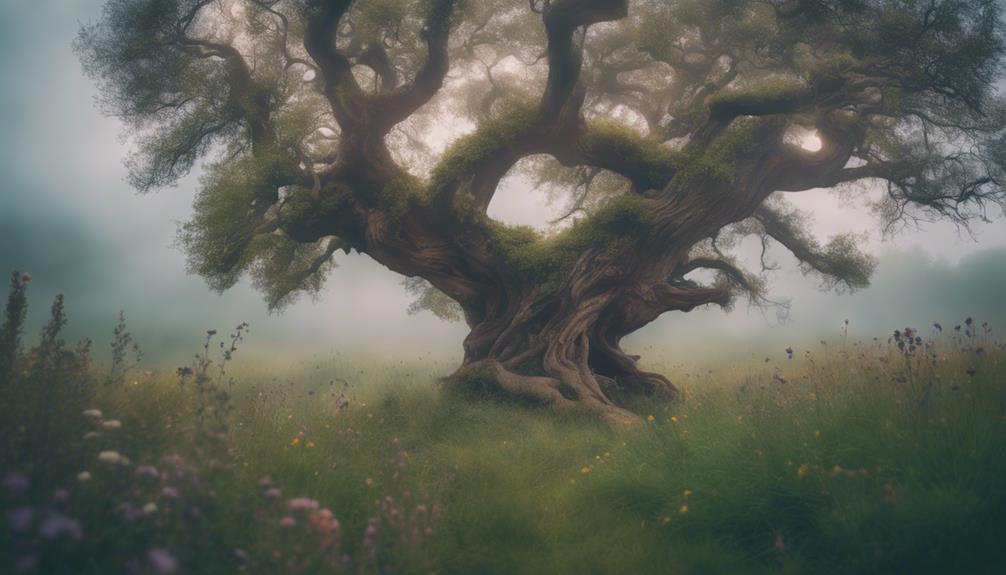The earliest recorded herbalists date back to ancient civilizations in Mesopotamia, Egypt, China, and India, where they developed sophisticated systems of medicine that harnessed the therapeutic potential of plants. In these ancient societies, herbal medicine was deeply rooted in cultural heritage, with clay tablets, papyri, and texts documenting medicinal plants and remedies. The contributions of these early herbalists have greatly influenced the evolution of herbalism, shaping the course of medicinal practices. As we explore the rich history of herbal medicine, we uncover the timeless wisdom of our ancestors, illuminating the path to a deeper understanding of the intricate relationships between humans, plants, and health.
Key Takeaways
• Shen Nong, the Divine Farmer, is considered one of the earliest herbalists, living over 5,000 years ago in ancient China.
• Ancient Mesopotamia's clay tablets listed medicinal plants, showcasing the early use of herbal medicine in ancient civilizations.
• The Ebers Papyrus, an ancient Egyptian text, contains over 700 plant-based remedies, demonstrating the significance of herbalism in ancient medicine.
• Ayurvedic tradition in India dates back over 3,000 years, highlighting the long history of herbalism in traditional medicine.
• The contributions of ancient herbalists like Shen Nong greatly influenced the development of herbalism, shaping ancient medicinal practices.
Ancient Roots of Herbal Medicine
Tracing the ancient roots of herbal medicine reveals a rich tapestry of civilizations that leveraged the medicinal properties of plants to heal and nurture their communities.
Herbal medicine predates modern pharmaceutical sciences by millennia, with ancient Mesopotamia boasting clay tablets listing medicinal plants dating back to 3000 BCE.
Ancient Egypt's Ebers Papyrus contained over 700 plant-based remedies, while Shen Nong, the Divine Farmer, lived over 5,000 years ago in China.
Ayurvedic tradition in India dates back over 3,000 years, and Hippocrates and Dioscorides from Greece and Rome respectively contributed significantly to herbal knowledge.
Indigenous cultures across continents have rich herbalist histories, showcasing the universal understanding of plants' healing properties.
These ancient practices laid the foundation for modern herbal medicine.
Cultural Heritage of Herbalism

The cultural heritage of herbalism is a testament deeply rooted in ancient cultures, reflecting societies' understanding of nature, spirituality, and biology.
Ancient Egypt and China had advanced herbal knowledge, with Ayurveda and Chinese traditional medicine being holistic systems.
Indigenous cultures globally use local plants for medicinal purposes, passing down rich herbal knowledge through generations.
Monasteries in Europe preserved herbal knowledge during the medieval period, while the Renaissance sparked interest in classical knowledge and herbals.
The cultural heritage of herbalism is a proof to the collective wisdom of ancient societies, showcasing their intricate understanding of the natural world and its medicinal properties.
This rich cultural heritage has shaped the foundation of modern herbal practices, influencing the development of pharmacopoeias and traditional medicine systems.
Evolution of Herbal Knowledge
As ancient societies evolved, their herbal practices developed from observational, trial-and-error methods to more sophisticated, documented approaches, setting the stage for modern pharmacopoeias and traditional medicine systems. This shift marked a noteworthy milestone in the evolution of herbal knowledge.
- Herbal practices became more systematic, with the establishment of pharmacopoeias and traditional medicine systems.
- Written records of herbal remedies and their uses became more prevalent, allowing for the preservation and dissemination of knowledge.
- The rise of holistic systems like Ayurveda and traditional Chinese medicine further expanded the scope of herbal knowledge.
- The contributions of ancient herbalists, such as Shen Nong and Dioscorides, greatly influenced the development of herbalism.
- The evolution of herbal knowledge has been shaped by the interplay of cultural, spiritual, and scientific factors.
Renaissance of Traditional Practices

During the Renaissance, a resurgence of interest in classical knowledge sparked a renewed focus on traditional herbal practices, leading to a revitalization of ancient wisdom.
This period saw a flourishing of herbal literature, with the publication of detailed herbals that described plants and their medicinal uses in great detail. The works of Dioscorides and Galen were revisited, and new discoveries were made, contributing to a deeper understanding of plant properties and their applications.
As a result, traditional herbal practices experienced a resurgence, with a renewed emphasis on the importance of botanical knowledge. This revival played a significant role in shaping the course of herbal medicine, paving the way for future generations of herbalists and practitioners.
Blending Tradition With Science
Modern herbalism combines traditional wisdom with scientific methods to enhance the credibility and effectiveness of herbal practices. This integration has deepened our comprehension of medicinal plants, validating their role in modern healthcare. Key aspects of this approach include the standardization of herbal extracts for quality assurance, conducting clinical trials to confirm efficacy, identifying active compounds and their mechanisms, creating innovative herbal formulations and delivery methods, and fostering collaboration between traditional herbalists and scientific researchers.
This harmonious blend of ancient knowledge and contemporary science has not only elevated the status of herbalism but has also paved the way for its increased acceptance and utilization as a complementary therapy.
Preserving Ancient Wisdom Today

While modern herbalism continues to evolve, it is equally important to preserve the ancient wisdom that has been passed down through generations. Safeguarding the rich cultural heritage of herbal traditions remains vibrant and intact. This preservation is essential in maintaining the authenticity and efficacy of traditional herbal remedies.
Efforts to document and translate ancient texts, such as the Ebers Papyrus and Shennong's Pen Tsao, have helped to protect this knowledge for future generations. Additionally, the preservation of traditional practices and oral traditions of indigenous cultures is crucial in keeping the wisdom of ancient herbalists alive.
Timeless Impact of Herbal Legacy

One of the most significant aspects of ancient herbalism is its profound and enduring impact on modern medicine, with the cumulative knowledge of ancient herbalists continuing to influence contemporary pharmacological advancements. The legacy of ancient herbalists has shaped the course of medicinal practices, with their discoveries and innovations paving the way for modern breakthroughs.
Ancient herbalism's emphasis on observation and experimentation laid the groundwork for modern scientific methods.
The use of plant-based remedies in ancient cultures has inspired modern research into botanical medicine.
Ancient herbalists' understanding of the human body and its connection to nature has influenced modern holistic approaches to health.
The preservation of ancient herbal knowledge has facilitated the development of new medicines and treatments.
The timeless impact of ancient herbalism is a tribute to the ingenuity and innovation of our ancestors, whose contributions continue to shape the future of medicine.
Frequently Asked Questions
How Did Ancient Herbalists Document Their Knowledge and Discoveries?
Ancient herbalists documented their knowledge and discoveries through various means, including clay tablets, papyri, and manuscripts. The Ebers Papyrus, for instance, contains over 700 plant-based remedies.
Similarly, Shen Nong's Pen Tsao and Dioscorides' De Materia Medica are esteemed herbal texts. Indigenous cultures relied on oral traditions, passing down knowledge through generations.
These documentation methods allowed ancient herbalists to record and share their findings, laying the foundation for modern herbal medicine.
What Role Did Spirituality Play in Ancient Herbal Practices?
In ancient herbal practices, spirituality played a significant role, often intertwining with medicinal knowledge. Many cultures believed that plants held spiritual properties, and their use was guided by spiritual principles.
For example, in traditional Chinese medicine, the concept of Qi and the balance of yin and yang influenced the selection of herbs. Similarly, in Ayurveda, the connection between the natural world and human well-being was deeply rooted in spiritual beliefs.
This spiritual dimension continues to influence modern herbalism, shaping the way practitioners approach plant-based remedies.
Were Ancient Herbal Remedies Only Used for Medicinal Purposes?
Ancient herbal remedies were not solely used for medicinal purposes. Many ancient cultures employed herbs in rituals, ceremonies, and spiritual practices, believing that plants held spiritual and mystical properties.
Herbs were used to invoke spiritual connections, ward off evil spirits, and promote spiritual growth. In some cultures, herbs were used in divination, shamanic practices, and to communicate with ancestors.
The multifaceted uses of herbs demonstrate the interconnectedness of ancient medicinal, spiritual, and cultural practices.
How Did Ancient Herbalists Identify and Classify Medicinal Plants?
Ancient herbalists employed various methods to identify and classify medicinal plants. For instance, the ancient Greek physician Dioscorides used observation, experimentation, and documentation to categorize plants based on their physical characteristics, habitats, and medicinal properties.
He recorded his findings in De Materia Medica, a thorough pharmacopeia that remained a seminal work for centuries. This systematic approach allowed ancient herbalists to develop a sophisticated understanding of medicinal plants, laying the foundation for modern pharmacology.
Did Ancient Herbalists Have a Concept of Pharmacology and Dosing?
In ancient herbalism, the concept of pharmacology and dosing was inherent, albeit not explicitly defined. Herbalists used trial and error, observation, and experiential knowledge to determine best dosages and preparation methods. They understood the importance of dosage, preparation, and individualization, often using empirical methods to adjust treatments.
While not based on modern pharmacological principles, ancient herbalists demonstrated a practical understanding of pharmacology and dosing through their successful treatment of ailments and preservation of herbal knowledge.
Conclusion
In a paradoxical twist, the passage of time has both preserved and threatened the ancient wisdom of herbalists.
As modern pharmacology advances, it is imperative that the earliest herbalists' contributions are still revered, yet their legacy is often overlooked.
Amidst the convergence of traditional and scientific approaches, it is essential to recognize the timeless impact of herbalism, ensuring its preservation for future generations.










